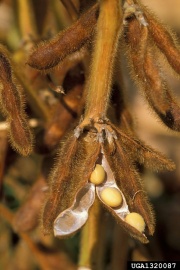Difference between revisions of "Soybean"
(Created page with "thumb|Soybean == Description == An edible species of legume of the cultivated soybean plant, ''Glycine max''. Originally native to Asia, t...") |
|||
| Line 7: | Line 7: | ||
''Glycine max''; soy; soya bean; soja (Esp., Fr.); soia (It); Chinese bean; | ''Glycine max''; soy; soya bean; soja (Esp., Fr.); soia (It); Chinese bean; | ||
| − | + | [[File:Uemura 10-08-2009 360.jpg|thumb|Silk dyed with soybean extract<br>Uemera Dye Archive]] | |
== Resources and Citations == | == Resources and Citations == | ||
* See also [[http://cameo.mfa.org/wiki/Category:Uemura_dye_archive '''Uemera Dye Archive''' (Daizu)]] | * See also [[http://cameo.mfa.org/wiki/Category:Uemura_dye_archive '''Uemera Dye Archive''' (Daizu)]] | ||
Revision as of 13:42, 18 June 2020
Description
An edible species of legume of the cultivated soybean plant, Glycine max. Originally native to Asia, the soybean is now cultivated throughout the world. Soybeans are used in the production of soy milk, tofu, soy sauce, tempeh and numerous vegetarian food products. When preseed the beans produce an oil that dries slowly to form a soft, clear film. The film, however, remains tacky and darkens with age. Soybean oil has been used as an Additive in alkyd-based industrial paints. Soybean glue is a vergetable glue made from remnants of the beans left after the oil extraction. The water soluble material has been used in plywood as we as for sizing and coating paper. The water-soluble portion of the crushed beans has also been used as a fabric dye.
Synonyms and Related Terms
Glycine max; soy; soya bean; soja (Esp., Fr.); soia (It); Chinese bean;
Resources and Citations
- See also [Uemera Dye Archive (Daizu)]

